Menus
- Even faster, even better?
- Aprilia RSV4 RF with cornering ABS
- Huge, double-pipe exhaust lobe
- Drivability as the key to fast lap times

Photo: Aprilia
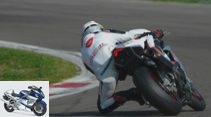
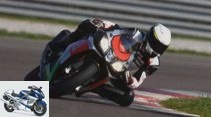
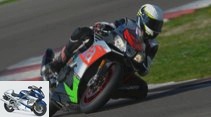

22nd photos
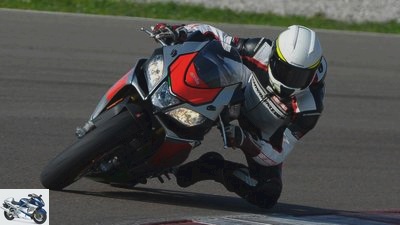
1/22
On the track, Aprilia’s RSV4 superbike weapon is a force to be reckoned with. The revised RF version goes one better with lighter wheels and Ohlins dampers.

2/22
The only goal in developing the RSV4 is to build the fastest superbike.
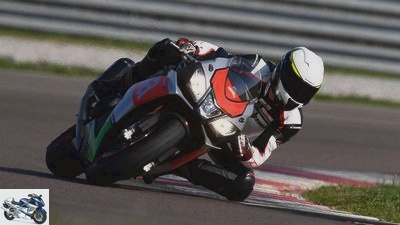
3/22
In addition to the brake pressure, the lean angle is now also displayed – up to 56 ° in our test drives.
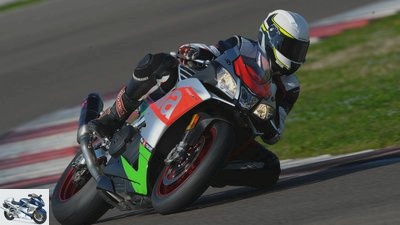
4/22
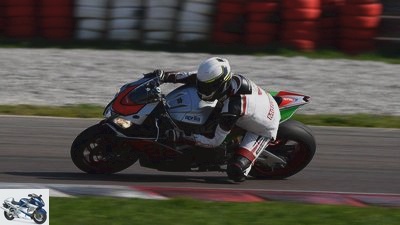
5/22
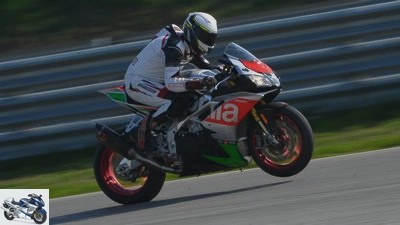
6/22
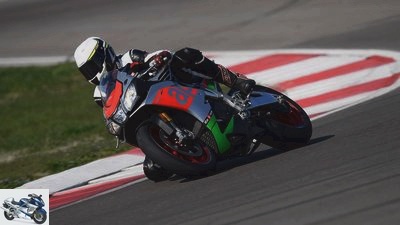
7/22
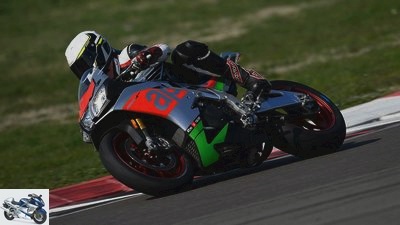
8/22
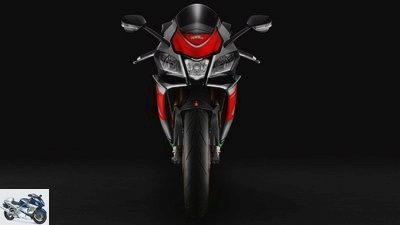
9/22
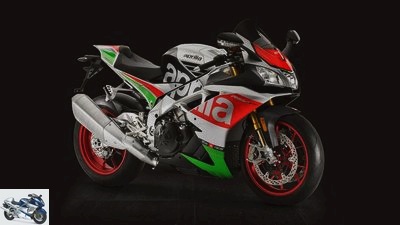
10/22
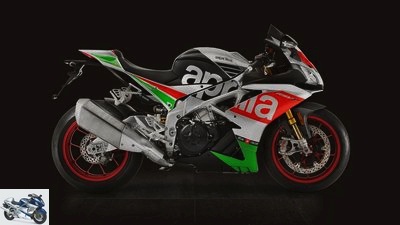
11/22
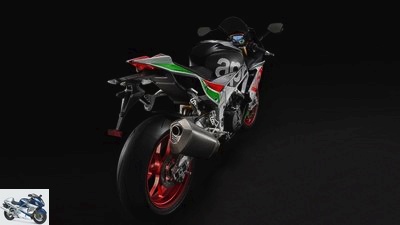
12/22
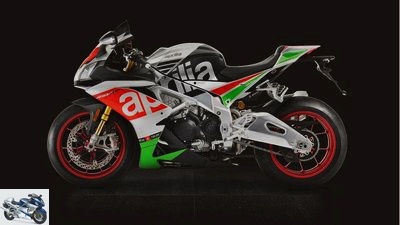
13/22
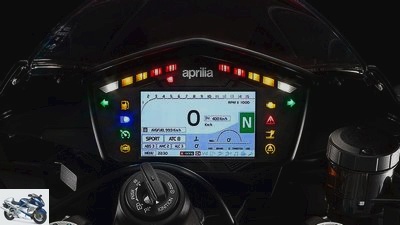
14/22
First-class TFT display that now also shows brake pressure and lean angle.
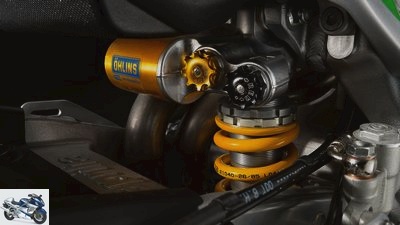
15/22
The TTX strut received a completely new set-up due to the changed deflection.
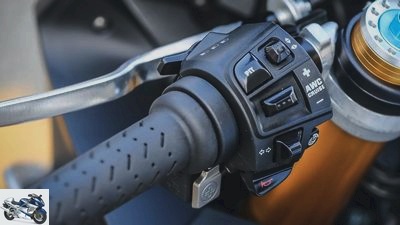
16/22
Lots of switches, yet easy to use. Smart: the joystick, which was a bit fiddly.
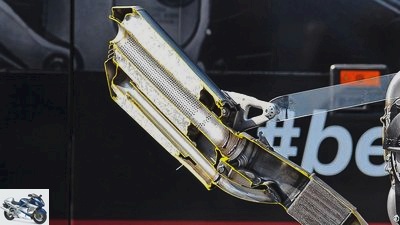
17/22
Up to 5500 rpm, a flap in the exhaust sends the exhaust gas flow through a labyrinth in the lower chamber.
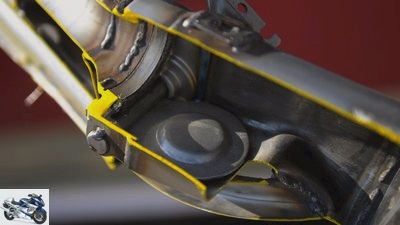
18/22
From 5500 rpm, the exhaust flap lies flat and discharges the exhaust gas directly into the open.

19/22
The velocity stacks are now two-part and rigid. The top funnel is designed to focus the airflow.
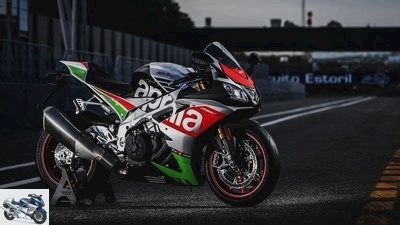
20/22
Despite the powerful exhaust, the old one: namely a racer through and through. Cast magnesium oil pan, clutch cover and generator cover save weight.
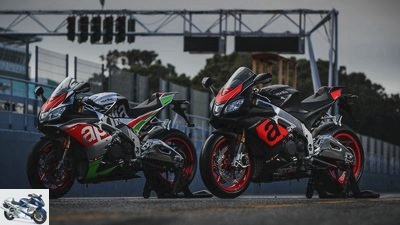
21/22
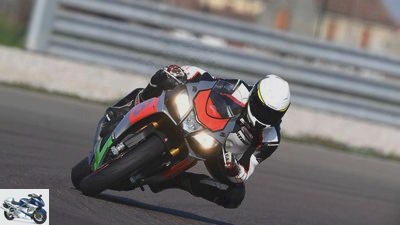
22/22
Aprilia RSV4 RF (2017) in the driving report
Even faster, even better?
Aprilia’s RSV4 superbike weapon is a force on the racetrack. She won the last comparison test on this terrain easily. So that it stays that way, it has now been revised. The Aprilia RSV4 RF with light wheels and Ohlins dampers gave a first taste of their skills.
The only goal in developing the A.prilia RSV4 is to build the fastest superbike. So the press release. And then that: a cruise control. The revised RSV4 actually has that too. But not because she really needs him. But because their revised electronics package, including a brilliant TFT display, will also be used in the Tuono in the future. With Aprilia’s Superbike derivative, other things were in focus for the revision: speed and lap times. And Aprilia has done more than the first glance suggests.
Buy complete article
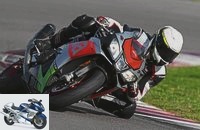
Aprilia RSV4 RF in the driving report
Even faster, even better?
RSV4 RF on the test bench
Aprilia RSV4 RF with cornering ABS
First of all, there is said electronics: The electronics package called APRC (Aprilia Performance Ride Control) has been completely redesigned. This applies to the electronic throttle (ride-by-wire), the wheelie control and the launch control. Completely new is the TFT display already mentioned, which now shows not only the brake pressure but also the lean angle – up to during the test drives with the Aprilia RSV4 RF, and in addition to the pit lane speed limiter also the automatic gearshift, which now also enables clutch-free downshifting when the vehicle is open Throttle allowed. In the event that one rushes into a curve in too high a gear. So much in advance: It actually works. The smooth anti-hopping clutch is actually only needed to start up. In view of the far protruding, still non-adjustable hand lever, this is not a fault.
The Bosch 9.1 ABS with rear wheel lift detection is now also suitable for bends and can be set in three levels, whereby level one may apply as a race setting: then rear wheel ABS and the cornering function are deactivated. For better signal processing, the IMU is now positioned at a 45-degree angle in the rear of the frame instead of horizontally. The crowning glory of the electronics package is the Aprilia RSV4 RF’s standard (RR optional) multimedia platform, with which, among other things, the electronics can be adjusted for each curve for twelve stored racetracks.
Huge, double-pipe exhaust lobe
On the chassis, an 800 gram-saving Ohlins NIX fork of the latest generation and a TTX shock absorber take care of the damping work. The latter is supported by a modified deflection on the swing arm. As a result, it gets by with a spring rate of 85 N / mm (2016: 105 N / mm). Softer springs with 100 instead of 105 N / mm are also used for the fork. The finest material also for the brakes. Brembos M50 pliers, together with 330 mm large and 5 mm thick discs, provide deceleration. And so that things can continue to move forward despite Euro 4, the cam profiles of the V4 have been refined and the valve springs have been reinforced. Because the V4 can now continue to turn up to 14,400 and thus 300 rpm. This is also made possible by pistons that are 30 grams lighter, which minimize blow-by losses and whose piston pins have a DLC coating.
Incidentally, the variable intake funnels are passe. Now two-part rigid and 500 gram lighter funnels channel the air flow. It’s worth the effort: Despite Euro 4, the RSV4, both as the RR and the Aprilia RSV4 RF, which was available for testing, produces 210 hp at 13,000 rpm. That it couldn’t have been easy to comply with the noise levels is testified by the huge, double-pipe exhaust lobe. The lion’s share of the approximately 2.5 kilograms weight gain of the RSV4 goes to them. Up to 5,500 rpm, a flap in the exhaust sends the exhaust gas flow through a labyrinth. From this mark on, it closes this detour and paves the exhaust gases the direct route to the outside.
Drivability as the key to fast lap times
At this moment, the pit lights on the Cremona racetrack south of Milan also clear the way. A rather narrow course, more suitable for 600 than for potent superbikes. A good 85 percent of a lap takes place here in second or third gear. After all, a 900 meter straight provides an opportunity for muscle games. The Aprilia RSV4 RF pushes on the track with full roar. The test machines were equipped with Akrapovic racing exhaust and matching mapping for the first sniff. At least so the V4 hangs razor-sharp on the gas, goes to work directly, quickly and without jerk. An absolute plus in the narrower sections of the route. As in the hairpin to start-finish, which is taken at low speed in second gear. The V4 starts work with ultra-precision when the throttle valve is opened, so the power input can be dosed with millimeter precision. It’s fantastic how evenly the V4 then fires through the rev range. Driveability is a key to fast lap times, the V4 offers it. Only at the last 700 rpm does the vigor decrease, which means that the 300 revs maximum speed gained can be regarded as overspeed reserves.
The first impression that the elegant fork is surprisingly soft compared to the shock absorber gives way to the feeling of great balance on the track. In connection with the enchanting handiness, jagged changes of inclination are a snap. A quick bend makes the Aprilia RSV4 RF, which differs from the RR version with its incredibly filigree forged wheels and its Ohlins spring elements, with unchanged stability and precision. The greedy turning in, the feeling of “driving over the front wheel” of the RSV4 is simply a force. However: If you slide backwards while accelerating and cling too tightly to the handlebars, the Aprilia RSV4 RF reacts with pendulums, which it then carries with it on the following straight. In return, however, it rewards shifting weight forward by quickly subsiding the movement.
So the track turns out to be a good touchstone for the Aprilia RSV4 RF. Because on the one hand, thanks to its maneuverability, it can be shooed through the narrow sections of the route, while on the other hand its electronics work very efficiently. The traction control, which can still be operated from the handlebars, regulates gently if necessary, the wheelie control without excessive intervention. And when anchoring hard, the lift detection keeps the rear wheel safely on the ground. Only the brakes did not play completely at this high level. Blessed with powerful braking power, it missed something in terms of spontaneous, powerful biting the first time it was put on. The feeling for the front wheel when turning on the brake could be a bit crisper. But apart from that, the Aprilia RSV4 RF presents itself well trained and in top shape to go forward and defend its supremacy on the racetrack against the strengthened competition. Whether or not she succeeds is in the big racetrack shootout in MOTORRAD 11/2017.
Related articles
-
Aprilia RSV4 – endurance test interim balance
Endurance test interim result: Aprilia RSV4 Aprilia’s super sports car in the test As an editor, you can also be unlucky. Sitting there in…
-
Endurance test final balance: Aprilia RSV4 R
Bilski endurance test final balance: Aprilia RSV4 R The super sports car from Aprilia after 50,000 km After the start of superbike life for the RSV4 R …
-
Driving report Aprilia SMV 750 Dorsoduro
Artificial driving report Aprilia SMV 750 Dorsoduro Easy game Crisp design, playful handling, full power, good manners ?? …
-
Driving report Aprilia RXV 4.5
Soldano driving report Aprilia RXV 4.5 on new paths V-twin-cylinder, petrol injection, unusual framework concept ?? two years ago surprised …
-
Driving report: Aprilia RSV4 Factory APRC SE
Aprilia driving report: Aprilia RSV4 Factory APRC SE Biaggis world champion bike in exclusive series trim The RSV4 Factory comes as APRC SE with a bundle …
-
Driving report: The Aprilia RSV4, tuned by Bikeshop-Luchow
Archive driving report: Luchow-Aprilia RSV4 The Aprilia RSV4, tuned by Bikeshop-Luchow, content of In the middle of the inline four-cylinder all sorts in …
-
Premiere: Aprilia RSV4 Factory APRC SE
Manufacturer Premiere: Aprilia RSV4 Factory APRC SE The first series Aprilia with electronic assistance systems. Content of In the future, only those…
-
Driving report Aprilia RSX 550
Bilski driving report Aprilia RSX 550 self-made Supersport After the 250cc two-stroke engines and lively 400cc four-stroke engines, which were canceled without replacement …
-
Driving report Aprilia RXV 550
Driving report Aprilia RXV 550 Second Level With the first super-light sports two-cylinder, Aprilia caused a lot of unrest in the off-road camp. MOTORRAD could …
-
Aprilia RSV4 RF and Yamaha YZF-R1M in comparison test
40 pictures markus-jahn.com 1/40 Aprilia RSV4 RF and Yamaha YZF-R1M in the comparison test. markus-jahn.com 2/40 You sit quite high on both bikes, on the …